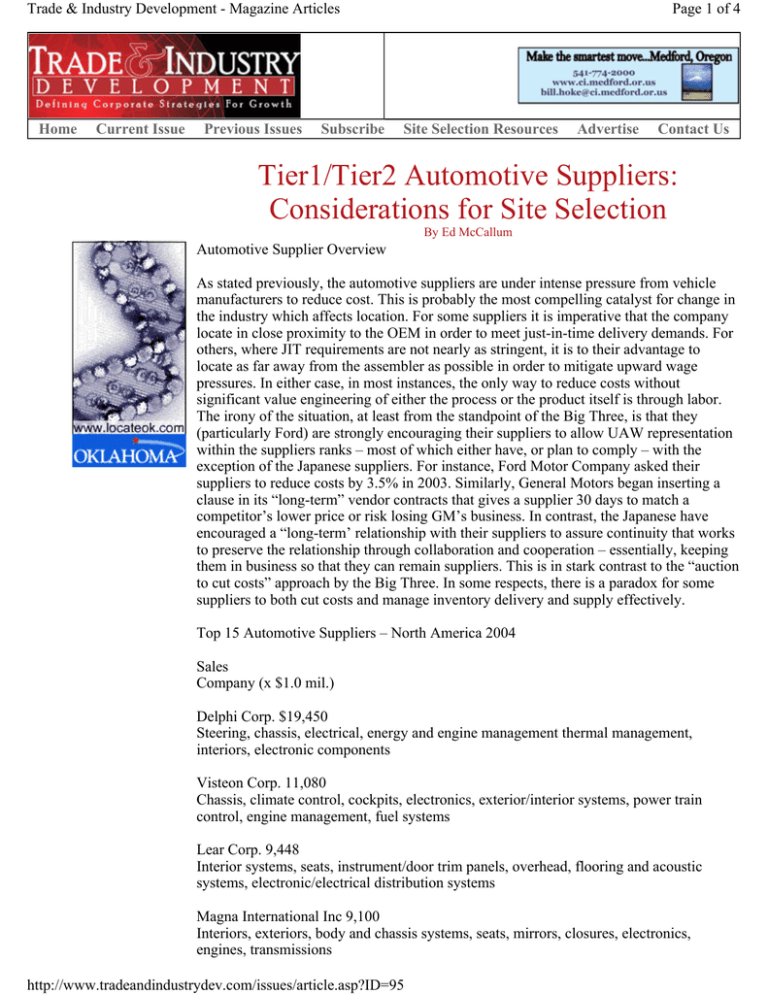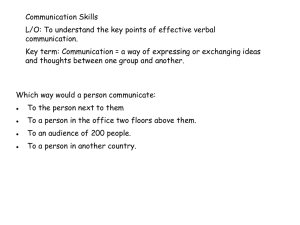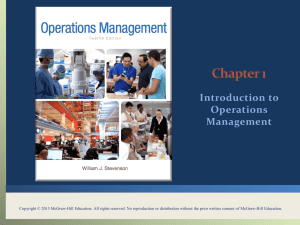Page 1 of 4 Trade & Industry Development - Magazine Articles
advertisement

Trade & Industry Development - Magazine Articles Home Current Issue Previous Issues Subscribe Page 1 of 4 Site Selection Resources Advertise Contact Us Tier1/Tier2 Automotive Suppliers: Considerations for Site Selection By Ed McCallum Automotive Supplier Overview As stated previously, the automotive suppliers are under intense pressure from vehicle manufacturers to reduce cost. This is probably the most compelling catalyst for change in the industry which affects location. For some suppliers it is imperative that the company locate in close proximity to the OEM in order to meet just-in-time delivery demands. For others, where JIT requirements are not nearly as stringent, it is to their advantage to locate as far away from the assembler as possible in order to mitigate upward wage pressures. In either case, in most instances, the only way to reduce costs without significant value engineering of either the process or the product itself is through labor. The irony of the situation, at least from the standpoint of the Big Three, is that they (particularly Ford) are strongly encouraging their suppliers to allow UAW representation within the suppliers ranks – most of which either have, or plan to comply – with the exception of the Japanese suppliers. For instance, Ford Motor Company asked their suppliers to reduce costs by 3.5% in 2003. Similarly, General Motors began inserting a clause in its “long-term” vendor contracts that gives a supplier 30 days to match a competitor’s lower price or risk losing GM’s business. In contrast, the Japanese have encouraged a “long-term’ relationship with their suppliers to assure continuity that works to preserve the relationship through collaboration and cooperation – essentially, keeping them in business so that they can remain suppliers. This is in stark contrast to the “auction to cut costs” approach by the Big Three. In some respects, there is a paradox for some suppliers to both cut costs and manage inventory delivery and supply effectively. Top 15 Automotive Suppliers – North America 2004 Sales Company (x $1.0 mil.) Delphi Corp. $19,450 Steering, chassis, electrical, energy and engine management thermal management, interiors, electronic components Visteon Corp. 11,080 Chassis, climate control, cockpits, electronics, exterior/interior systems, power train control, engine management, fuel systems Lear Corp. 9,448 Interior systems, seats, instrument/door trim panels, overhead, flooring and acoustic systems, electronic/electrical distribution systems Magna International Inc 9,100 Interiors, exteriors, body and chassis systems, seats, mirrors, closures, electronics, engines, transmissions http://www.tradeandindustrydev.com/issues/article.asp?ID=95 Trade & Industry Development - Magazine Articles Page 2 of 4 Johnson Controls Inc. 8,021 Seats, interior trim batteries, electronics, cockpits and instrument panels Dana Corp. 5,543 Axles, drive shafts, structures; sealing, thermal management, fluid transfer; engine power products, chassis, steering and suspension products Robert Bosch Corp. 5,000 Fuel injection systems, chassis systems, energy and body systems, automotive multimedia and electronics TRW Automotive Inc. 4,633 Steering, suspension, braking, engine components, fasteners, occupant restraint systems, electronic safety and security Denso Int. America Inc. 3,894 Thermal, power train control, electronic and electric systems; small motors, industrial and environmental systems ThyssenKrupp Auto. 3,650 Body systems, chassis modules, power trains, suspensions, steering systems, drive trains American Axle 3,536 Chassis and driveline systems, forged products, axle driveline modules Collins & Aikman Corp. 2,908 Cockpit modules, instrument panels, flooring and acoustic systems, fabrics, trim, convertible top systems and accessory mats DuPont Automotive 2,755 Coatings, engineering polymers, fibers, chemicals, refrigerants and finishes, small motor and transmission components Continental 2,280 Electronic brakes, stability management systems, tires, president foundation brakes, chassis systems, safety system electronics Yazaki North America Inc 2,242 Electrical distribution systems, electronics, instrumentation, connectors and components It is inevitable that some suppliers will go overseas. For instance, it appears that less sophisticated components such as batteries, wheels, plastics, electronics and some power train components will not stay in the US for long. Market forces are dictating this inevitable occurrence, though the speed varies significantly by manufacturer. It is estimated that by 2010, US and Canadian parts manufacturing capacity will drop 17%. However, of the 50 top global OEM automotive parts suppliers, 19 are headquartered in the US and account for 43.6% of the top 50 companies’ worldwide sales of $300.0 billion in 2002. The most outsourced parts of the vehicle include interior systems and components, door panels, fuel systems, braking systems and steering systems. The North American Industry Classification (NAIC) codes designate the following sub categories for tracking employment in the automotive supplier sector: 336211 Motor Vehicle Body Manufacturing 336311 Carburetor, Piston, Piston Ring, and Valve Manufacturing http://www.tradeandindustrydev.com/issues/article.asp?ID=95 Trade & Industry Development - Magazine Articles Page 3 of 4 336312 Gasoline Engine and Engine Parts Manufacturing 336321 Vehicular Lighting Equipment Manufacturing 336322 Other Motor Vehicle Electrical and Electronic Equipment Manufacturing 336330 Motor Vehicle Steering and Suspension Components 336340 Motor Vehicle Brake System Manufacturing 336350 Motor Vehicle Transmission and Power train Parts Manufacturing 336360 Motor Vehicle Seating and Interior Trim Manufacturing 336370 Motor Vehicle Metal Stamping 336391 Motor Vehicle Air-Conditioning Manufacturing 336399 All Other Motor Vehicle Parts Manufacturing The NAIC codes for tires and tubes (326211 and 326212) and storage battery manufacturing (335911) are not included in the \ NAIC code definition of automotive parts, because they are not broken out to a level identifying only those meant for motor vehicle use. However, tires, tubes, and storage batteries for automotive use are part of the Office of Automotive Affairs’ Harmonized Tariff System (HTS) trade definition Mergers and Acquisitions The only two remaining US owned automakers are Ford and General Motors. Chrysler Motor Company and Daimler-Benz merged in 1998 to create a 92 billion dollar company that was, at that time, the largest acquisition-merger to ever take place. This laid out the pattern that would be repeated over and over by the suppliers which is continuing to evolve. Debt level among the top 25 suppliers tripled during the period 1995 to 2001 and have only lessoned slightly in the last three years. It is estimated by the Original Equipment Suppliers Association (OESA) that the US automotive industry will lose half of its domestic parts suppliers by 2010 because of demands from automakers for cost and price cuts. On average, automakers and Tier 1 suppliers demanded an average of 6.1% in price reductions while Tier 2 and 3 suppliers agreed to cuts of 3.6%. The continuation of this trend has only one inevitable outcome – suppliers will be forced to consolidate to remain competitive or simply go out of business altogether. This has already manifested itself with some of the largest US suppliers such as Lear Corp, Visteon, Dana and Tenneco. They will most likely either expand and improve existing operations, or shut them down entirely. Obviously this will not apply in many respects to a new automotive assembly announcement where some suppliers will follow. The effects of agglomeration combined with consolidation will alter this picture slightly. Agglomeration – Domestic vs. Foreign Significant and telling research has been performed by Thomas Klier, Paula Ma and Daniel P. McMillan that pointed out the distinct differences in the location patterns of domestic versus foreign producers. The most telling result of this research is that the location patterns of suppliers reflect the emphasis on different operational philosophies. Supply chain management issues are driving most of the location decisions for suppliers regardless of whether they are foreign or domestic. Proximity to efficient reliable transportation infrastructure is probably the most important location criteria for both suppliers. Interestingly, foreign suppliers show a stronger “highway effect” indicating that interstate highways or interstate quality highways are virtually a must in their location decision-making. In addition, foreign suppliers have a tendency to locate in close proximity to other foreign suppliers. One can only speculate as to the exact reason for this; however, JIT and inventory management is greatly enhanced by proximity to interstate highways. In addition, there should be little argument that there are indeed synergies that can be captured by locating near other like industries and cooperating http://www.tradeandindustrydev.com/issues/article.asp?ID=95 Trade & Industry Development - Magazine Articles Page 4 of 4 toward a common goal. Whether this is a cultural issue or in fact a distinct difference in operational philosophies remains to be seen. In general, as a result of mergers and acquisitions, industry consolidation, demands for cost reductions and the need to maintain flexibility in supplying more than one OEM, suppliers are concentrating more and more regionally. The location of an assembly plant is without a doubt the greatest determinant of location from a regional perspective – unless there is the ability to diversify the customer base with either multiple OEM’s or even totally different product lines. This is occurring as a natural consequence of mergers and acquisitions, but it is also a direct result of regional competitive pressures that force greater flexibility in defining sole sourced customer relationships and even cross industry product lines. Considerations in Supplier Location There are some general trends to consider when evaluating different locations. Some are the consequence of the competitive environment; others are activities that are a unique collaboration between the demands if the OEM and a market response of the public/private sectors. • Proximity to Interstate systems (or highways of comparable quality) with quick efficient access to the assembly plant can mitigate the need for adjacent location to OEM’s of many Tier 1 suppliers • Automotive business parks provide a distinct advantage for those suppliers who produce complex modules with intense J-I-T requirements • Transportation infrastructure for suppliers – with an emphasis on time of delivery considerations • Components that require more labor and less sophisticated technology will grow fastest abroad and depart North America. Complex manufacturing will favor those locations that have quick startup capabilities (i.e. skills, training, certification, buildings, sites, etc.) • Product life cycles are shorter than ever and will continue to speed up – reduce time to market includes available sites and facilities, out of the box thinking regarding specific customized training (i.e. Six Sigma, TS 16949 certification similar to the ISO 9000 series of the past) and R&D capabilities outside of Detroit • Cost pressure to the supplier means every production input counts – mitigate not only development costs but ongoing operating costs such as utilities, taxes, etc. Back ©2003-2005 Trade & Industry Development http://www.tradeandindustrydev.com/issues/article.asp?ID=95







